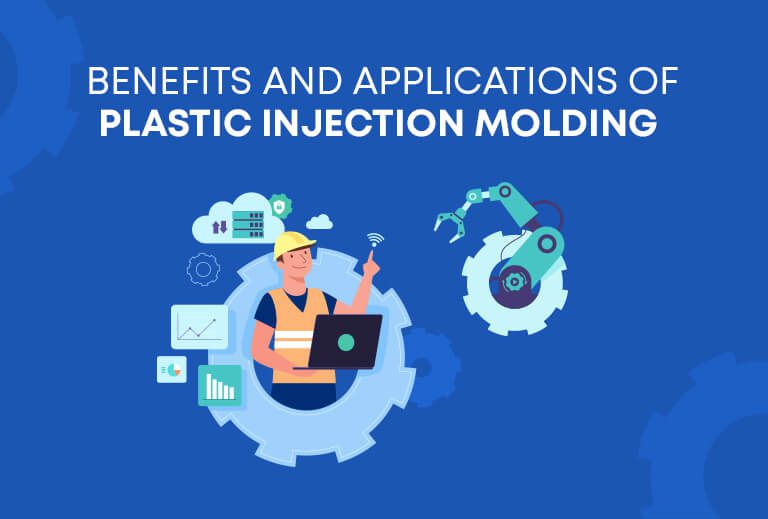4 Automation Benefits in Plastic Injection Molding
When performed by an experienced professional plastic molder using automated machinery, plastic injection molding procedures are fast, efficient, and exact.
Each manufactured component will be identical to the initial design file and other units in the order using appropriate modern equipment and automation technology.
Automated injection molding technology can ensure that the same amount of material is injected into the mold every time, at the same pressure, and in the same amount of time, as well as a slew of other variables.
This blog post will go over the benefits and applications of these systems in further detail.
Widespread Advantages in Plastic Injection Molding
Because automated systems can handle most components of the job without operator intervention, automation is becoming more common in all types of manufacturing. This leads to a slew of benefits for the industry:
- Machine utilization is enhanced: Interconnected automated systems communicate through a centralized control system. This type of injection molding equipment will generate analytics that will allow users to find areas for improvement and inform human operators when parts fail or require inspection.
- Increased productivity: Robotic systems can complete tasks without being interrupted. Automated systems that are well-maintained may run 24 hours a day, seven days a week, result in higher per-unit productivity and faster order fulfillment.
- Labor costs are lower: Robotic systems can perform tasks that traditionally needed numerous people, allowing businesses to take on more orders with fewer employees. Lower direct labor expenses, as well as associated cost savings, result in lower overall project costs.
- Environment-friendly manufacturing: Automated machines generate less waste from rejected or deformed components because they produce enormous volumes of products with low error rates.
What is automated plastic injection molding applications?
Plastic injection molding automation is useful in a wide range of industries and applications. Automated processes are commonly used for:
- Unloading and Loading: If manual techniques are used to load and unload plastic injection molding equipment, a lot of space is consumed. Robots can establish an ideal working environment in which they can perform efficiently in restricted spaces and load and unload machinery without the risk of human error. In addition, automated machinery employs the same amount of shot material per cycle, resulting in uniform and precise results.
- Quality control and visual inspection: Robotics and automation allow humans to supervise inspection operations. Robots can orient pieces, detect dimensional mistakes with sensors, and more.
- Assembly/sorting/stacking: After the mold stage, robotic devices can execute difficult jobs. Welding to construct assemblies, sorting and organizing parts for kits or packaging procedures, and other duties are among them. These features lower the possibility of error and expedite the order fulfillment process.
- Secondary services: Secondary processes, like decoration and labeling, are frequently required for molded items. To conduct these jobs fast and accurately, smart systems can use side-entry injection molding robots.
As the industry moves forward, it is imperative that manufacturers and raw material providers know how their products are best served. The automation of every aspect of plastic material is here, more so in the injection molding sector.
Leave a Reply Cancel reply
Recent Posts
- Understanding The Materials That Are Used To Build Plastic Toys
- All You Need To Know About Food-grade Plastics
- A Glance At The Materials That Boost The Performance Of Plastics
- Understanding The Importance Of Exploring New Business Opportunities In The Plastic Industry
- Understanding The Importance Of Investing in R&D For The Plastic Industry
Categories
- 3D Printing
- AIPMA
- Automation
- Automobile Sector
- Bio Plastics
- Environment
- Innovations In Recycling
- Latest Innovations
- Molds & Dies
- News
- Packaging Industry
- Plastic
- Plastic Application
- Plastic Industry
- Plastic Market
- Plastic Myths
- Plastic News From The World
- Plastic Packaging
- Plastic Products
- Plastic Recycling
- Plastic Solar Cells
- Plastic Toys
- Plastic Waste
- Plastic World
- Plastics
- Plastics And Their Applications
- Plastics In Agriculture
- Plastics In Healthcare
- Plastics In Medical Industry
- Plasticulture
- Processing Machinery
- Recycling Machines
- Robotics
- Uncategorized
- Virtual Reality
Archives
- November 2023 (3)
- October 2023 (2)
- September 2023 (3)
- August 2023 (3)
- July 2023 (3)
- June 2023 (3)
- May 2023 (2)
- April 2023 (2)
- March 2023 (2)
- February 2023 (2)
- January 2023 (2)
- December 2022 (3)
- November 2022 (1)
- October 2022 (1)
- September 2022 (2)
- August 2022 (1)
- July 2022 (3)
- May 2022 (3)
- March 2022 (2)
- February 2022 (1)
- January 2022 (1)
- September 2021 (2)
- August 2021 (3)
- July 2021 (4)
- June 2021 (4)
- May 2021 (3)
- April 2021 (2)
- March 2021 (4)
- November 2019 (8)
- October 2019 (8)
- September 2019 (8)
- August 2019 (8)
- July 2019 (8)
- June 2019 (8)
- May 2019 (8)
- April 2019 (8)
- March 2019 (8)
- February 2019 (11)
- January 2019 (8)
- December 2018 (8)
- November 2018 (12)
- October 2018 (12)

